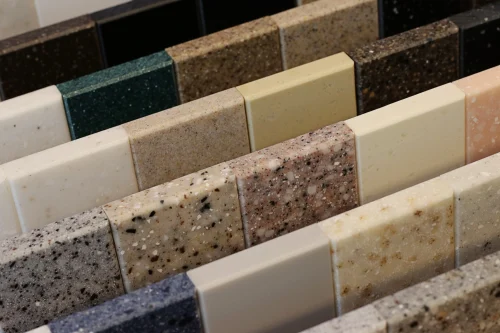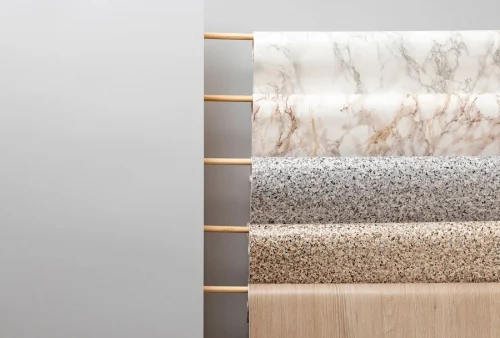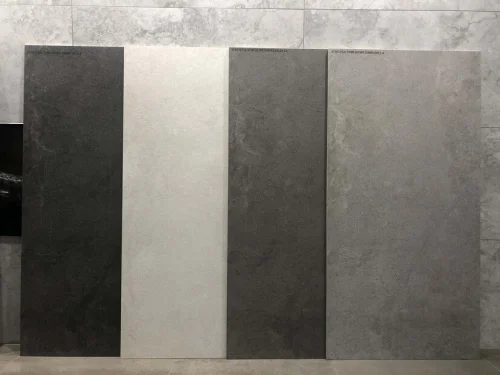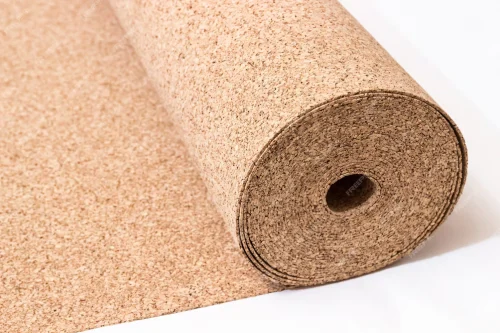
Do Wooden Kitchen Cabinets Have the Magic to Turn Your Kitchen Into a Rustic Retreat?
March 26, 2025
Which Clear Glass Is Right for Your Home? A Guide to Types & Uses
March 27, 2025Kitchens are often considered the hub of any household, where families gather, meals are prepared, and fond memories are made. Therefore, it is important to select the best kitchen floor tiles for aesthetic and functional reasons.
Heavy foot traffic and spillage on kitchen floors are inevitable, so choosing durable, long-lasting flooring for kitchen is essential for durability, maintenance, and appearance. This guide can assist with selecting tiles for your kitchen floor by providing different materials and factors to consider.
Best Materials For Kitchen Floor Tiles
Selecting tiles for the kitchen requires careful thinking when choosing materials to decorate its floor since your selection will determine its look and functionality.
Below are the best materials to use:
1. Ceramic Tiles -
Ceramic tiles are a top choice of flooring for kitchen due to their easy maintenance requirements and various design possibilities.
Constructed from natural clay, they come in multiple styles, colours, and finishes for your flooring needs. For greater design flexibility, ceramic tiles can also mimic more expensive materials like wood and stone.

2. Porcelain Tiles
Porcelain tile is a refined version of ceramic tiles distinguished by its water resistance and durability. It is perfect for kitchen use due to its ability to withstand high traffic levels and moisture.
Porcelain tiles come in many styles, ranging from modern, sleek designs to rustic textures with matte, glossy, or textured finishes, enhancing their aesthetic appeal in your kitchen space.

Read more - Vastu for Plots
3. Natural Stone Tiles
If you want a luxurious and timeless look in your kitchen, natural stone tiles like slate, granite, or marble may be needed. Boasting their distinct natural beauty with unique patterns, natural stone tiles provide unmatched durability while adding an extravagant feel.
Natural stone tiles are costlier than porcelain or ceramic options. They must be sealed regularly to prevent staining and moisture build-up on their surface.

4. Vinyl Tiles
The popularity of vinyl tiles in modern kitchens comes from their affordability, ease of care, and variety of designs. Vinyl comes in luxury plank (LVPs) and luxury tile (LVTs), providing the same look as natural materials such as wood or stone without incurring additional expenses.
Vinyl tiles also boast stain resistance, waterproofness, and comfort underfoot, making them an excellent option for use in the kitchen environment.

5. Cement Ceramic Tiles
This can give your kitchen an unusual appearance by adding colour, texture and pattern. Cement ceramic tiles can give your kitchen an exciting, fresh new look by adding colour, texture and pattern.
Cement tiles, crafted of natural materials like cement or sand and available in various shapes and patterns, offer extreme durability against moisture intrusion and are moisture resistant. However, they need sealing to preserve their integrity and prevent staining.

Read more - 7 Different Styles of Facade
6. Hard Wood Flooring
Hardwood flooring is an evergreen classic that adds warmth, elegance, and natural beauty to any space. Renowned for its timeless charm and long-term investment value, hardwood comes in various species, colours, and finishes that create endless design opportunities.
When properly maintained, hardwood can stand the test of time, and natural variations create unique custom looks in each room, from rustic to modern settings.
 7. Cork Flooring
7. Cork Flooring
Cork flooring, crafted from the bark of cork oak trees, is an eco-friendly and sustainable alternative to traditional flooring options.
Crafted with a soft, cushioned feel underfoot, cork offers antimicrobial and hypoallergenic benefits, while moisture resistance offers soundproofing properties and thermal insulation properties that protect indoor air quality.
Cork has easy maintenance while being friendly towards the environment. It is truly an ecological option!

Read more - The Complete Guide to Furniture Dimensions
Final Thoughts
When selecting floor tiles for your kitchen, keep material durability, cleaning ease, design preferences, and budget in mind. Various materials and styles suit different designs.
Ceramic, porcelain, and natural stone tiles offer affordable options. In contrast, more luxurious natural stone options provide luxurious aesthetics. Adding style and visual interest with cork, hardwood and vinyl tiles will complete the design aesthetic, ensuring a beautiful and easy-to-maintain experience.
Choose colors and patterns that complement your kitchen’s overall theme. Remember to consider long-term maintenance needs to make the best investment.
Read more - Staircase as per Vastu
FAQs
What materials make the best kitchen floor tiles?
Ceramic, porcelain, and natural stones such as granite and slate are highly recommended for use as kitchen floor tiles; these durable yet water-resistant options make an excellent choice in high-traffic spaces that experience moisture build-up.
Are vinyl tiles suitable as kitchen flooring options?
Yes, luxury vinyl tiles (LVT) make an excellent addition to kitchens due to their affordability, easy maintenance, water resistance, and variety of designs which mimic wood, stone, and more.
How can I select the appropriate type of tile for kitchen floor?
When selecting an ideal tile type for your kitchen floor, consider these factors: durability, water resistance, maintenance needs, aesthetic appeal, and longevity. Ceramic, porcelain, and natural stone tiles offer various benefits that suit your needs.
Are cork tiles a good option for kitchen flooring?
Yes, cork tiles are a sustainable and comfortable choice for kitchen flooring. They are soft underfoot, providing comfort and reducing strain, and naturally resistant to mould and mildew. Cork’s insulation properties help maintain a cosy environment, and it’s an eco-friendly option that can enhance your kitchen’s warmth and charm.
How do I maintain kitchen floor tiles?
Maintaining kitchen floor tiles involves regular cleaning to prevent dirt and stains from building up. For ceramic, porcelain, and natural stone tiles, sweeping or vacuuming regularly is essential, along with using a damp mop for a deeper clean. Consider using a grout cleaner for grout lines, and for natural stones, and ensure periodic sealing to protect the surface from moisture and stains.








